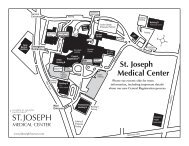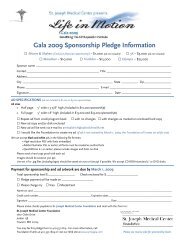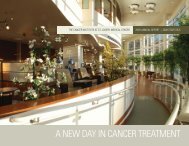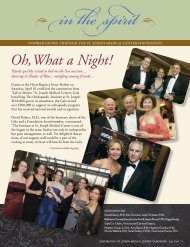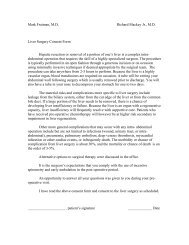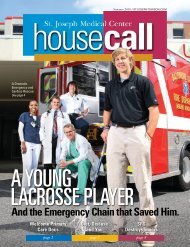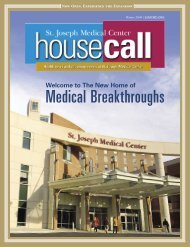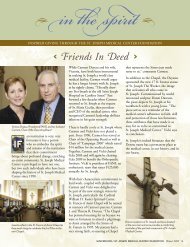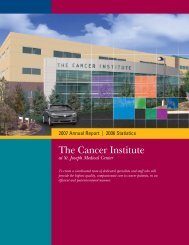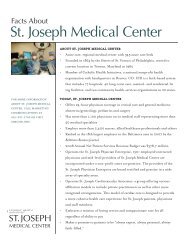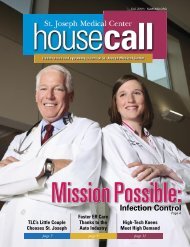ANNUAL REPORT - St. Joseph Medical Center
ANNUAL REPORT - St. Joseph Medical Center
ANNUAL REPORT - St. Joseph Medical Center
Create successful ePaper yourself
Turn your PDF publications into a flip-book with our unique Google optimized e-Paper software.
10<br />
SpyGlass Endoscope Technologies have greatly enhanced<br />
doctors’ ability to treat liver, pancreatic and other digestive<br />
problems at <strong>St</strong>. <strong>Joseph</strong> <strong>Medical</strong> <strong>Center</strong>. Through a process<br />
called SpyGlass Direct Visualization, this new endoscope<br />
provides a superb view of the biliary and pancreatic<br />
ducts. SpyGlass enables troubleshooting for conditions<br />
ranging from gallstones to cancer and leads to more exact<br />
and effective treatment.<br />
Using visualization provided by this high-tech tool, some<br />
patients suffering from large gallstones can be treated with<br />
lithotripsy (shock waves) and avoid surgery altogether.<br />
Operating Room Tracking Systems<br />
<strong>St</strong>. <strong>Joseph</strong> has undertaken an approach to effi ciency<br />
in patient care adapted from business and automobile<br />
manufacturing. The “LEAN TEAM” is leading the way to<br />
redesign the patient experience by looking at best practices<br />
and eliminating duplication or unnecessary steps.<br />
The LEAN TEAM’s eff orts focusing on the operating<br />
room have been bolstered by work with real-time location<br />
systems (RTLS). The Surgical Department worked with<br />
consultants to customize a model to track a patient’s<br />
progress through the surgical process and to make that<br />
information available to clinicians as well as to the<br />
patient’s family.<br />
Each surgical patient wears a badge that transmits to<br />
sensors throughout the surgical unit, enabling the system<br />
software to track that patient at any time through surgery.<br />
The Surgical Prep unit has designed the patient intake and<br />
assignment process to make the most eff ective use of this<br />
technology and to reduce wait times. Operating room staff<br />
members can easily monitor when the patient arrives and is<br />
ready for surgery. PACU (Post-Anesthesia Care Unit) staff<br />
can determine when patients are likely to complete surgery<br />
and can be prepared, even requesting a bed assignment in<br />
the medical center when the patient is nearing transfer.<br />
In the waiting room, loved ones can check the patient’s<br />
location at any time through the surgery process by reading<br />
the information next to a privacy-protected code assigned<br />
to the patient. As soon as the patient is admitted to a<br />
hospital room, the location is posted on the screen.<br />
In addition to the value of tracking patients in real time,<br />
the data collected provides information that can be<br />
analyzed to help improve patient fl ow and communication<br />
procedures for the future. Serving as the Alpha test site<br />
for ProcedureTracking has enabled clinicians to adjust<br />
procedures to improve effi ciency. Fewer surgery delays,<br />
decreased wait times for both patients and surgeons, and<br />
improved patient and family satisfaction are tremendous<br />
benefi ts realized already and showing even more promise<br />
for the future.<br />
SpyGlass operative team: Josh Foreman, M.D.; Andrew Rosenstein, M.D.; Lisa Hancock, O.R.T.




